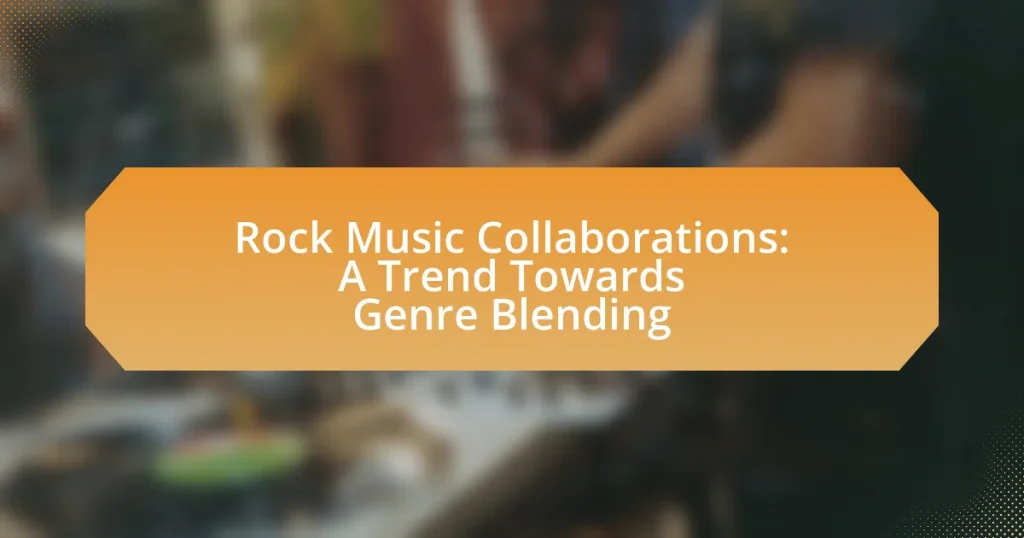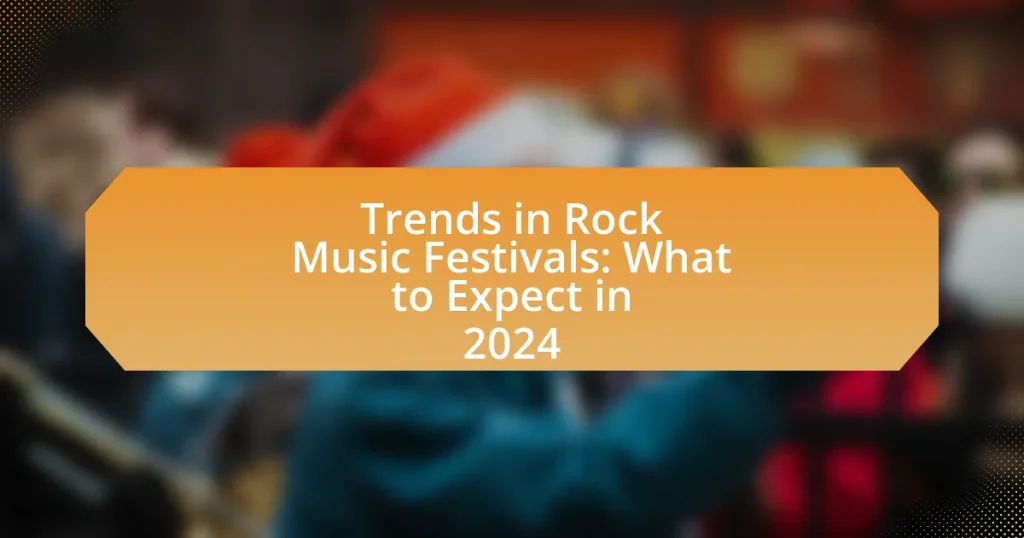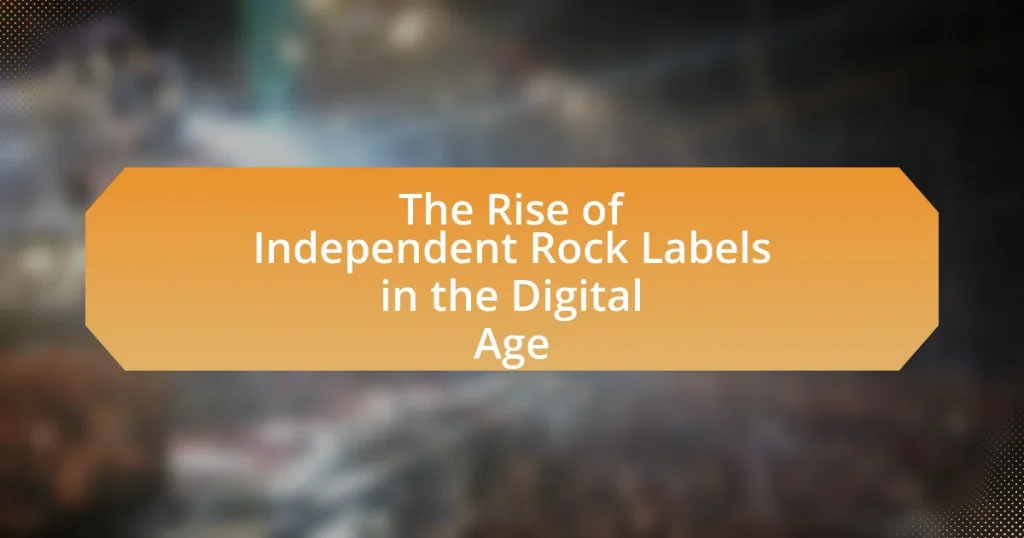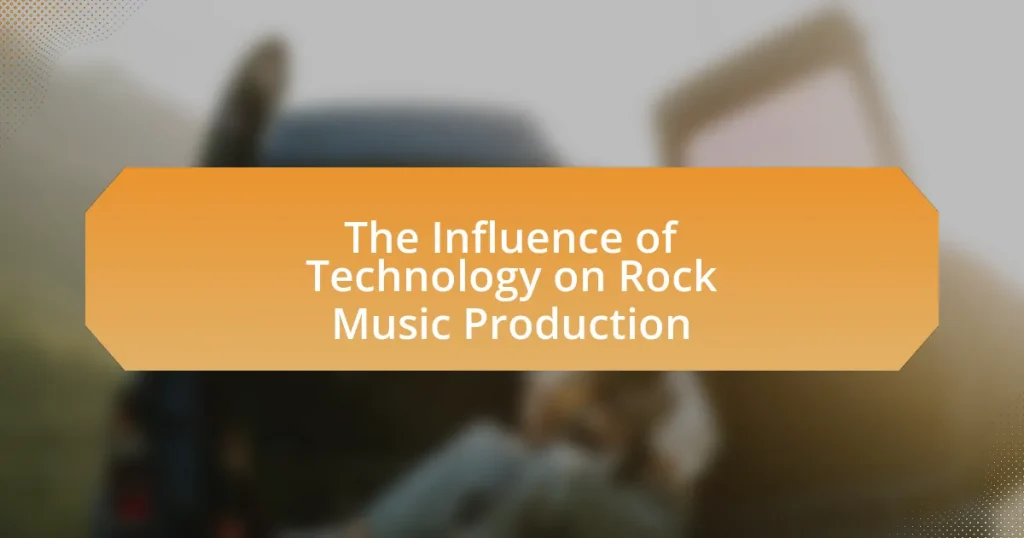Rock music collaborations represent a significant trend towards genre blending, where artists from diverse backgrounds unite to create innovative sounds. This article explores the evolution of these collaborations, tracing their roots from the 1960s to the present, highlighting key historical events and technological advancements that have facilitated this shift. It examines the significance of genre blending in expanding rock music’s appeal, the impact of notable collaborations on the genre, and how these partnerships reflect cultural trends and address social issues. Additionally, the article discusses future trends in rock music collaborations, emphasizing the role of technology and emerging genres in shaping the landscape of modern rock music.
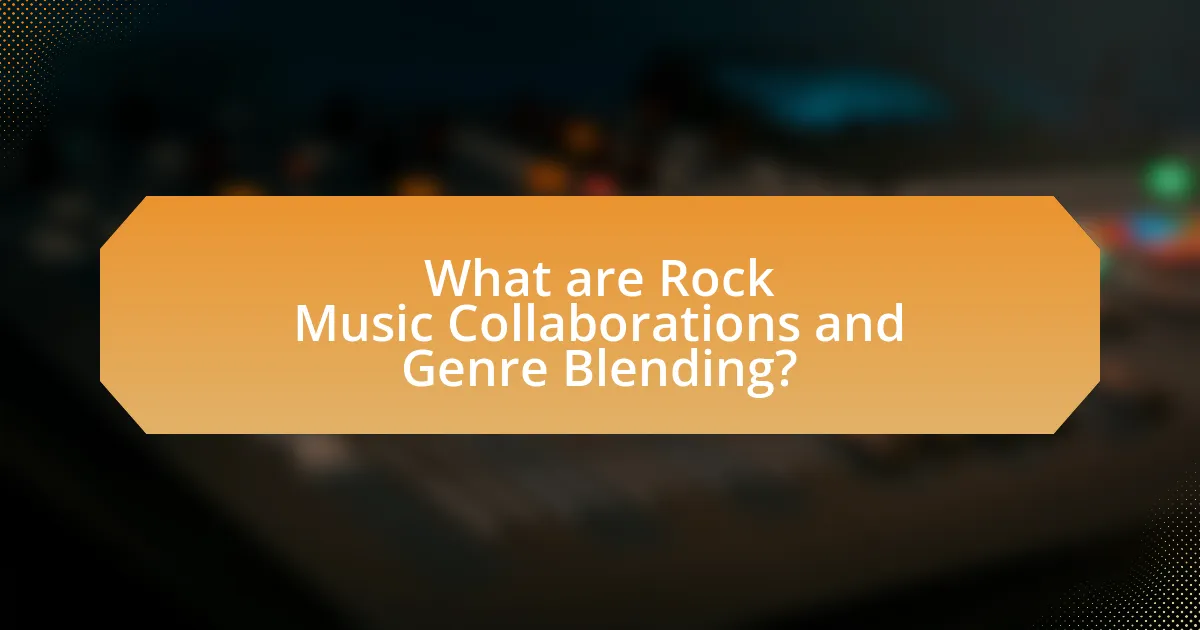
What are Rock Music Collaborations and Genre Blending?
Rock music collaborations involve artists from different backgrounds or genres working together to create new music, while genre blending refers to the fusion of rock with other musical styles, resulting in innovative sounds. Collaborations can enhance creativity and reach diverse audiences, as seen in projects like the collaboration between Aerosmith and Run-D.M.C. on “Walk This Way,” which merged rock and hip-hop, leading to a resurgence in both genres. Genre blending has become increasingly popular, with artists like Linkin Park incorporating elements of electronic and hip-hop into their rock sound, demonstrating the versatility and evolving nature of rock music.
How have Rock Music Collaborations evolved over time?
Rock music collaborations have evolved from isolated partnerships primarily within the genre to increasingly diverse and genre-blending collaborations. In the 1960s and 1970s, collaborations often featured artists from the same rock subgenres, such as the supergroups formed by members of established bands, exemplified by Cream and The Traveling Wilburys. As the decades progressed, particularly in the 1990s and 2000s, rock artists began to collaborate with musicians from various genres, including hip-hop, pop, and electronic music, reflecting a broader cultural shift towards genre fusion. For instance, Aerosmith’s collaboration with Run-D.M.C. on “Walk This Way” in 1986 marked a significant moment in blending rock with hip-hop. This trend has continued into the 21st century, with artists like Post Malone and Halsey collaborating with rock musicians, further blurring genre lines and appealing to wider audiences. The evolution showcases a shift from traditional rock collaborations to innovative partnerships that redefine musical boundaries.
What historical events influenced the rise of collaborations in rock music?
The rise of collaborations in rock music was significantly influenced by the cultural shifts of the 1960s and 1970s, particularly the counterculture movement and the advent of music festivals. The counterculture movement fostered an environment of experimentation and collaboration among artists, leading to iconic partnerships such as the collaboration between David Bowie and Mick Jagger on “Dancing in the Street” in 1985. Additionally, the emergence of festivals like Woodstock in 1969 showcased diverse musical acts performing together, promoting genre blending and collaborative performances. These events not only encouraged artists to work together but also shaped the sound and direction of rock music, making collaborations a defining characteristic of the genre.
How have technological advancements impacted rock music collaborations?
Technological advancements have significantly enhanced rock music collaborations by facilitating remote recording and real-time communication among artists. Innovations such as digital audio workstations (DAWs), high-speed internet, and cloud-based platforms enable musicians from different geographical locations to collaborate seamlessly. For instance, the rise of software like Pro Tools and Ableton Live allows artists to share and edit tracks instantly, leading to more diverse and genre-blending collaborations. Additionally, platforms like Splice and SoundCloud provide spaces for artists to connect and share ideas, further promoting collaborative efforts across various musical styles.
Why is genre blending significant in rock music?
Genre blending is significant in rock music because it fosters innovation and expands the genre’s appeal. By incorporating elements from various musical styles, such as blues, jazz, punk, and hip-hop, rock artists create diverse sounds that attract a broader audience. For instance, the fusion of rock with hip-hop in the 1990s, exemplified by collaborations like Aerosmith and Run-D.M.C.’s “Walk This Way,” revitalized interest in both genres and showcased the potential for cross-genre creativity. This blending not only enhances artistic expression but also reflects cultural shifts, making rock music more relevant in a rapidly evolving musical landscape.
What are the key genres that commonly blend with rock music?
The key genres that commonly blend with rock music include pop, punk, metal, blues, and country. Rock music has historically integrated elements from these genres, creating diverse subgenres and styles. For instance, pop rock combines catchy melodies with rock instrumentation, while punk rock emphasizes fast tempos and rebellious themes. Metal incorporates heavier guitar riffs and complex structures, often drawing from blues for its emotional depth. Additionally, country rock merges storytelling and instrumentation from country music with rock’s energy, exemplified by artists like Lynyrd Skynyrd. This blending showcases rock music’s versatility and its ability to evolve by incorporating various musical influences.
How does genre blending enhance the creativity of rock artists?
Genre blending enhances the creativity of rock artists by allowing them to incorporate diverse musical elements and influences, which leads to innovative soundscapes and lyrical themes. This fusion of genres, such as rock with hip-hop, jazz, or electronic music, enables artists to break traditional boundaries, experiment with new structures, and reach broader audiences. For instance, the collaboration between rock bands and hip-hop artists has resulted in unique tracks that combine rhythmic complexity with melodic instrumentation, exemplified by the success of Linkin Park’s “Collision Course” with Jay-Z. Such collaborations not only expand the artistic palette of rock musicians but also foster a culture of experimentation that drives the evolution of the genre.
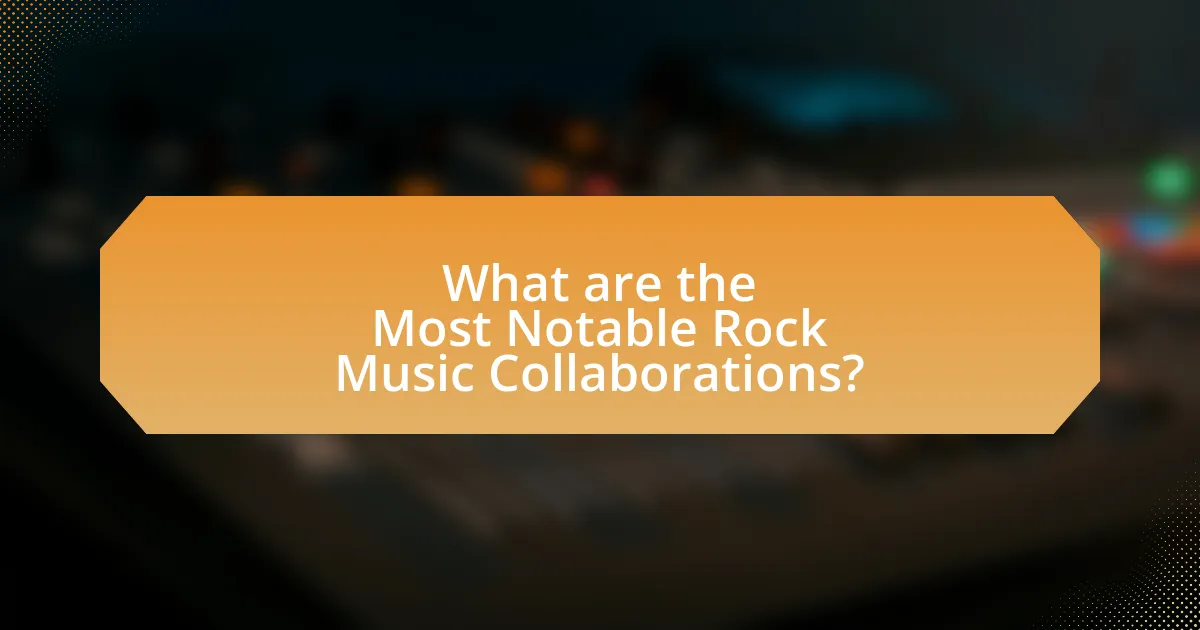
What are the Most Notable Rock Music Collaborations?
The most notable rock music collaborations include “Under Pressure” by Queen and David Bowie, “Walk This Way” by Aerosmith and Run-D.M.C., and “The Last Goodbye” by Jeff Buckley and Elizabeth Fraser. These collaborations are significant as they blend rock with other genres, showcasing the versatility and influence of rock music. For instance, “Under Pressure,” released in 1981, is renowned for its unique fusion of rock and pop elements, while “Walk This Way,” released in 1986, is credited with bridging the gap between rock and hip-hop, leading to a resurgence in Aerosmith’s popularity.
Which collaborations have had the greatest impact on the rock genre?
Collaborations that have had the greatest impact on the rock genre include the partnership between Aerosmith and Run-D.M.C. on “Walk This Way,” which bridged rock and hip-hop, revitalizing both genres in the 1980s. Another significant collaboration is the work of David Bowie and Queen on “Under Pressure,” which showcased the fusion of rock and pop elements, influencing countless artists. Additionally, the collaboration between Eric Clapton and B.B. King on the album “Riding with the King” highlighted the intersection of rock and blues, further shaping the sound of modern rock music. These collaborations not only produced iconic tracks but also expanded the boundaries of the rock genre, demonstrating its adaptability and influence across different musical styles.
What are some iconic songs that resulted from rock music collaborations?
Iconic songs that resulted from rock music collaborations include “Under Pressure” by Queen and David Bowie, “Walk This Way” by Aerosmith and Run-D.M.C., and “The Girl Can’t Help It” by Little Richard featuring various artists. “Under Pressure,” released in 1981, is renowned for its unique blend of rock and pop elements, showcasing the vocal interplay between Freddie Mercury and David Bowie. “Walk This Way,” a 1986 collaboration, successfully merged rock with hip-hop, revitalizing Aerosmith’s career and introducing a new audience to the genre. “The Girl Can’t Help It,” featuring Little Richard, exemplifies the fusion of rock and rhythm and blues, highlighting the collaborative spirit of the era. These songs not only achieved commercial success but also influenced the evolution of rock music by incorporating diverse musical styles.
How did these collaborations influence the artists involved?
Collaborations in rock music significantly influenced the artists involved by expanding their musical styles and audience reach. For instance, when rock artists collaborated with hip-hop or electronic musicians, they often incorporated new rhythms and production techniques, leading to innovative sounds that attracted diverse fan bases. A notable example is the collaboration between Aerosmith and Run-D.M.C. on “Walk This Way,” which not only revitalized Aerosmith’s career but also bridged the gap between rock and hip-hop, resulting in increased popularity for both acts. This blending of genres has been shown to enhance creativity and foster artistic growth, as artists experiment with different influences and collaborate across traditional genre boundaries.
What role do collaborations play in the careers of rock musicians?
Collaborations significantly enhance the careers of rock musicians by expanding their creative horizons and increasing their audience reach. When rock musicians collaborate with artists from different genres, they often blend styles, which can lead to innovative sounds and new fan bases. For instance, the collaboration between Aerosmith and Run-D.M.C. on “Walk This Way” in 1986 not only revitalized Aerosmith’s career but also introduced rock to hip-hop audiences, demonstrating the powerful impact of cross-genre partnerships. Additionally, collaborations can lead to increased visibility through joint tours and promotional efforts, further solidifying a musician’s presence in the industry.
How can collaborations help emerging artists gain recognition?
Collaborations can significantly help emerging artists gain recognition by expanding their audience reach and enhancing their credibility. When an emerging artist collaborates with established musicians, they tap into the latter’s fan base, which can lead to increased visibility and new listeners. For instance, a study by Nielsen Music found that collaborations often result in higher streaming numbers, as fans of both artists engage with the new work. Additionally, collaborations can provide emerging artists with valuable exposure through promotional opportunities and media coverage that they might not achieve independently. This synergy not only elevates their profile but also fosters networking opportunities within the industry, further solidifying their presence in the music scene.
What are the potential risks and rewards of collaborating in rock music?
Collaborating in rock music presents both significant risks and rewards. The primary risk involves creative differences, which can lead to conflicts and hinder the artistic process; for instance, the collaboration between the bands Aerosmith and Run-D.M.C. faced challenges due to differing musical styles. Conversely, the rewards include the potential for innovative sound and broader audience reach, as evidenced by the success of collaborations like Linkin Park and Jay-Z, which resulted in the critically acclaimed “Collision Course” album, expanding both artists’ fan bases. Thus, while collaboration can be fraught with challenges, it often leads to groundbreaking music and increased visibility in the industry.
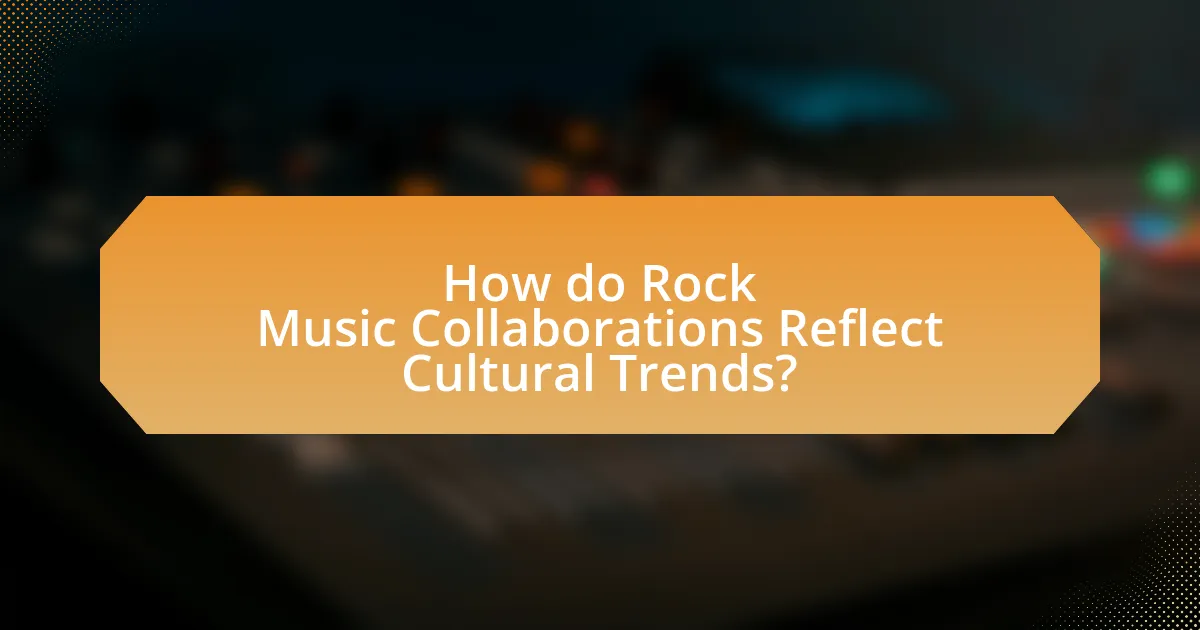
How do Rock Music Collaborations Reflect Cultural Trends?
Rock music collaborations reflect cultural trends by showcasing the blending of diverse musical styles and influences, which mirrors the increasing cultural interconnectivity in society. For instance, collaborations between rock artists and musicians from genres like hip-hop, pop, and electronic music, such as the partnership between Linkin Park and Jay-Z on “Collision Course,” highlight how artists are breaking traditional genre boundaries. This trend is further evidenced by the rise of genre-blending festivals and playlists that celebrate cross-genre collaborations, indicating a shift in listener preferences towards more eclectic and inclusive musical experiences.
In what ways do collaborations address social and political issues?
Collaborations in rock music address social and political issues by uniting diverse artists to amplify messages and foster awareness. For instance, the collaboration between artists like U2 and Green Day during the aftermath of Hurricane Katrina highlighted the need for disaster relief, raising significant funds and awareness. Additionally, projects like “We Are the World” brought together various musicians to address famine in Africa, demonstrating how collective efforts can mobilize public support and influence policy. Such collaborations leverage the artists’ platforms to engage audiences in critical conversations, thereby driving social change and political action.
How have collaborations responded to changes in audience demographics?
Collaborations in rock music have increasingly adapted to changes in audience demographics by incorporating diverse genres and influences to appeal to a broader listener base. For instance, artists are now blending rock with hip-hop, pop, and electronic music, reflecting the varied musical tastes of younger audiences. This shift is evidenced by successful collaborations such as those between rock bands and hip-hop artists, which have resulted in chart-topping hits and expanded fan engagement. Data from the Recording Industry Association of America indicates that genre-blending tracks have seen significant streaming increases, highlighting the effectiveness of this strategy in reaching diverse demographic groups.
What cultural movements have influenced rock music collaborations?
Cultural movements such as the counterculture of the 1960s, punk rock, and hip-hop have significantly influenced rock music collaborations. The counterculture movement, characterized by its rejection of mainstream values, led to collaborations that fused rock with folk and psychedelic elements, exemplified by artists like Bob Dylan and The Beatles. Punk rock introduced a DIY ethos and a blend of genres, encouraging collaborations that incorporated elements of reggae and new wave, as seen in bands like The Clash. Additionally, the rise of hip-hop in the 1980s and 1990s prompted rock artists to collaborate with rappers, creating genre-blending tracks that expanded the reach of both genres, such as Aerosmith’s collaboration with Run-D.M.C. on “Walk This Way.” These movements have shaped the collaborative landscape of rock music, fostering innovation and diversity in sound.
What are the future trends in Rock Music Collaborations?
Future trends in rock music collaborations will increasingly focus on genre blending, as artists seek to innovate and reach broader audiences. This trend is evidenced by recent successful collaborations between rock musicians and artists from genres such as hip-hop, electronic, and pop, exemplified by projects like the collaboration between Post Malone and Ozzy Osbourne on “Take What You Want.” Additionally, the rise of digital platforms facilitates cross-genre partnerships, allowing artists to experiment with diverse sounds and styles, thereby enhancing creativity and expanding their fan bases. The integration of technology in music production also supports these collaborations, enabling seamless fusion of different musical elements.
How might technology shape future collaborations in rock music?
Technology will significantly shape future collaborations in rock music by enabling seamless communication and creative integration across diverse genres. Advances in digital audio workstations, cloud-based collaboration tools, and artificial intelligence will allow musicians from different locations to co-create in real-time, breaking geographical barriers. For instance, platforms like Splice and Soundtrap facilitate remote collaboration, allowing artists to share and edit tracks instantly. Additionally, AI-driven tools can analyze musical trends and suggest innovative combinations, fostering genre blending that reflects contemporary influences. This evolution mirrors the rise of genre-blending collaborations seen in recent years, such as the fusion of rock with hip-hop and electronic music, demonstrating technology’s role in expanding artistic possibilities.
What emerging genres are likely to blend with rock music in the future?
Emerging genres likely to blend with rock music in the future include electronic music, hip-hop, and indie pop. The integration of electronic elements into rock has already been seen in bands like Imagine Dragons, which combines rock with synth-pop influences. Additionally, collaborations between rock artists and hip-hop musicians, such as Post Malone and Ozzy Osbourne, demonstrate a growing trend of genre fusion. Indie pop’s melodic and experimental qualities also align well with rock, as evidenced by artists like Tame Impala, who blend psychedelic rock with pop sensibilities. These trends indicate a future where rock music continues to evolve through collaboration with diverse genres.
What are some best practices for successful rock music collaborations?
Successful rock music collaborations require clear communication, mutual respect, and a shared vision among artists. Establishing open lines of communication ensures that all collaborators can express their ideas and feedback, fostering a creative environment. Mutual respect for each artist’s contributions enhances collaboration, as it acknowledges the unique strengths each member brings to the project. Additionally, having a shared vision helps align the creative direction, making it easier to blend different genres effectively. Research indicates that collaborations that prioritize these elements often result in innovative and successful musical outcomes, as seen in projects like the collaboration between Linkin Park and Jay-Z, which successfully merged rock and hip-hop elements.
